Walking the Moon with my own Photos - Half Moon
On these pages I do "moon walks" on the basis of my own photos. In other words, I try to name the objects on my lunar photos to get to know the moon better. Maybe these pages will help others to get to know the moon better as well...
This page shows (more or less) the Half Moon. See also page From Half Moon to Full Moon (RX10 M3).
Back to the overview of my "moon walks".
Introduction
The following photos show, more or less, the Half Moon. The following photos are either rotated by 180 degrees or mirrored so that they correspond to the normal visual impression.
Photos
Set 1
First, two photos, that were taken on May 2, 2017 - on May 3rd shortly before 4 a.m. was Half Moon. The photo were taken with the Sky-Watcher Explorer-102 OTA and with the camera held to the eyepiece (16 mm UWA and 7 mm UWA).
The crater Bessel (15-17 km in diameter) and the crater Posidonius P (15 km in diameter) can be easily seen in the 7 mm version, in the 16 mm version only with difficulty (it is better to see in the larger version). In the 7 mm version you can also see the craters Luther (10 km diameter) and Posidonius M (10 km diameter).
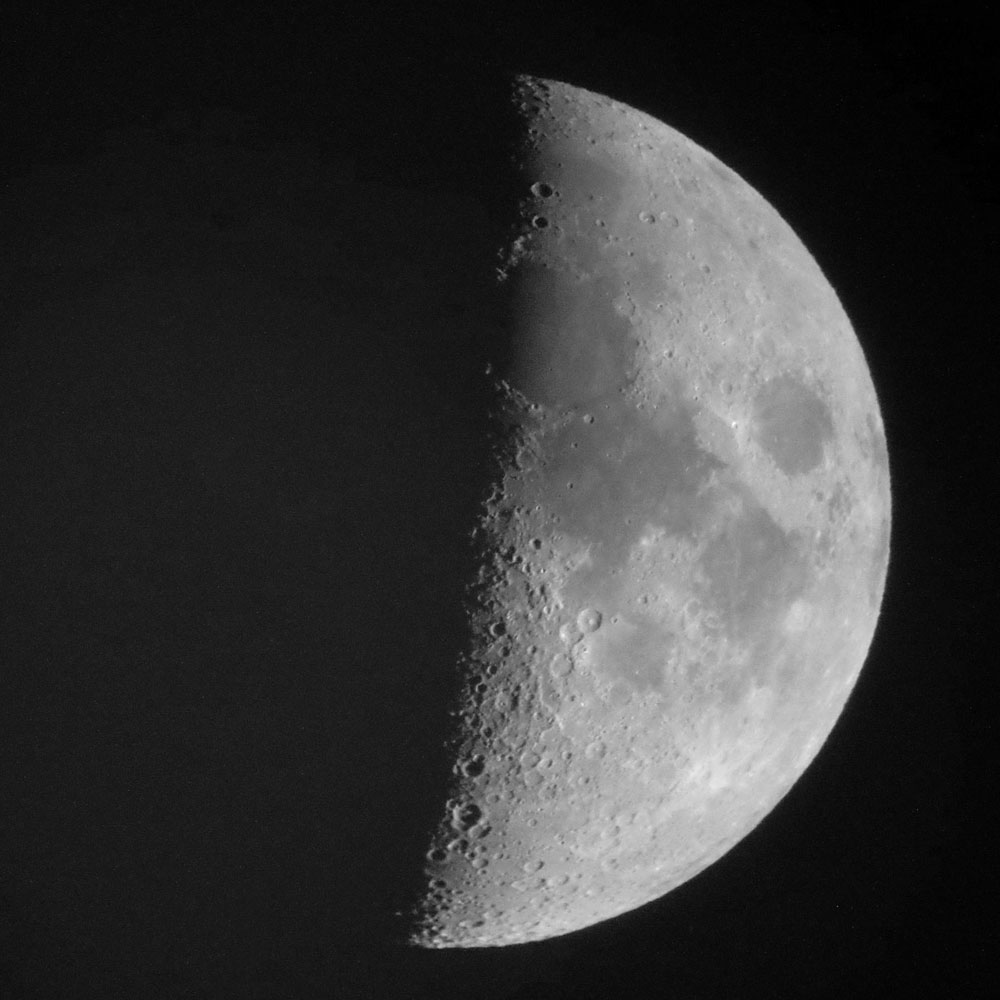 |
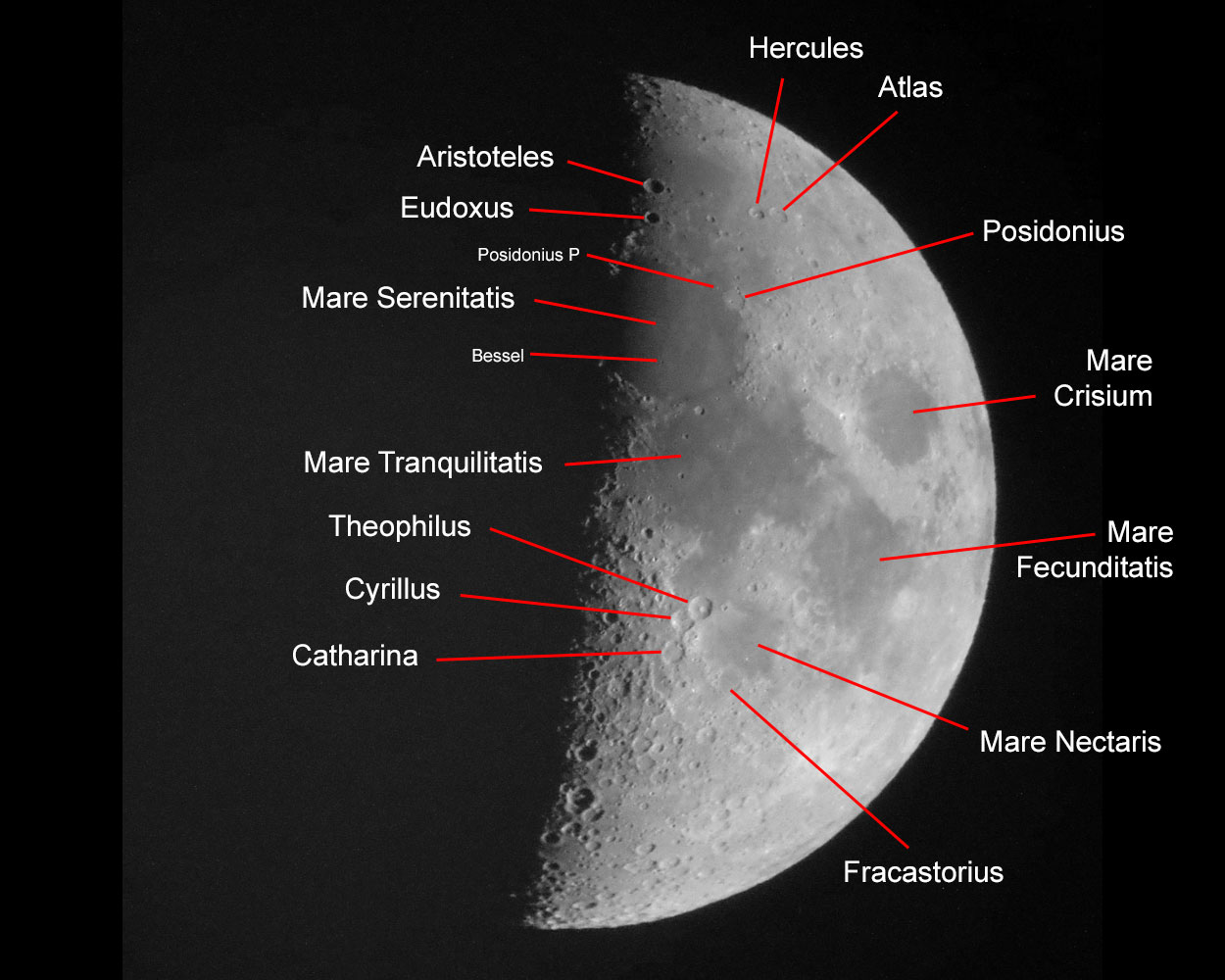 |
|
16 mm eyepiece |
||
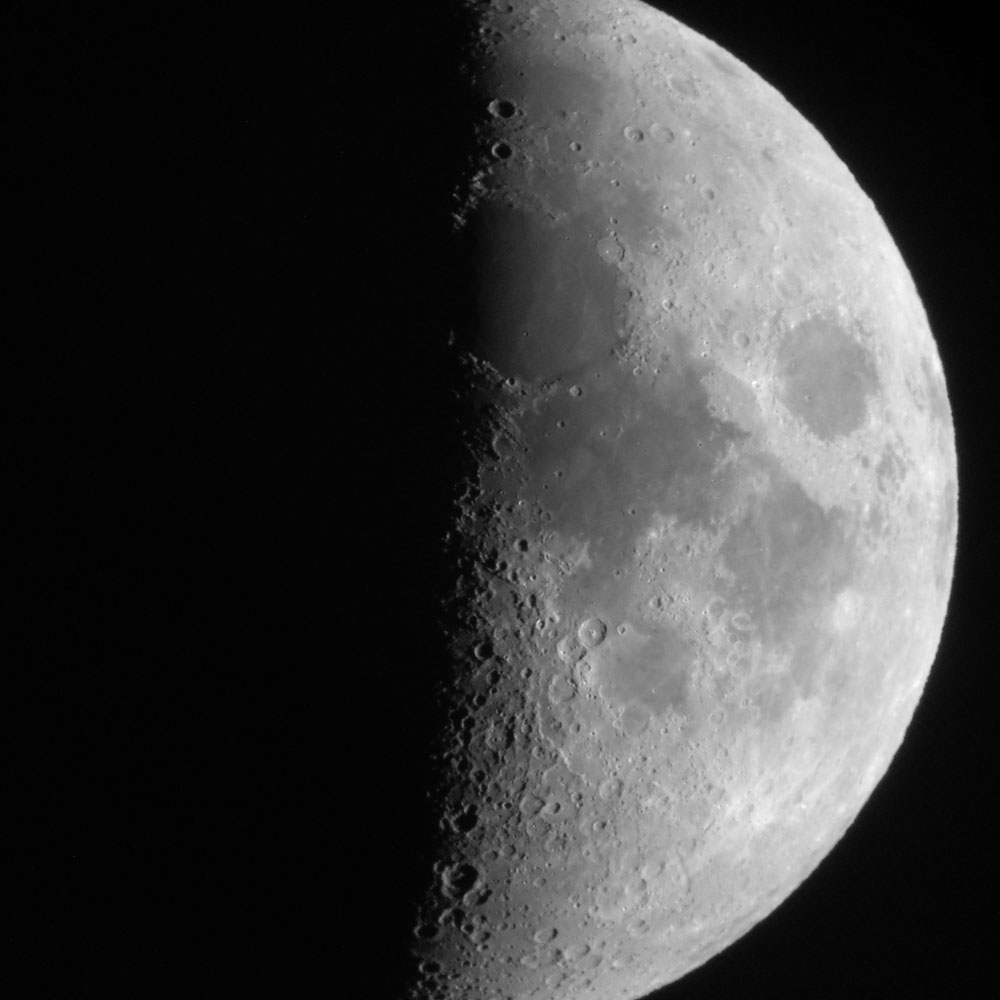 |
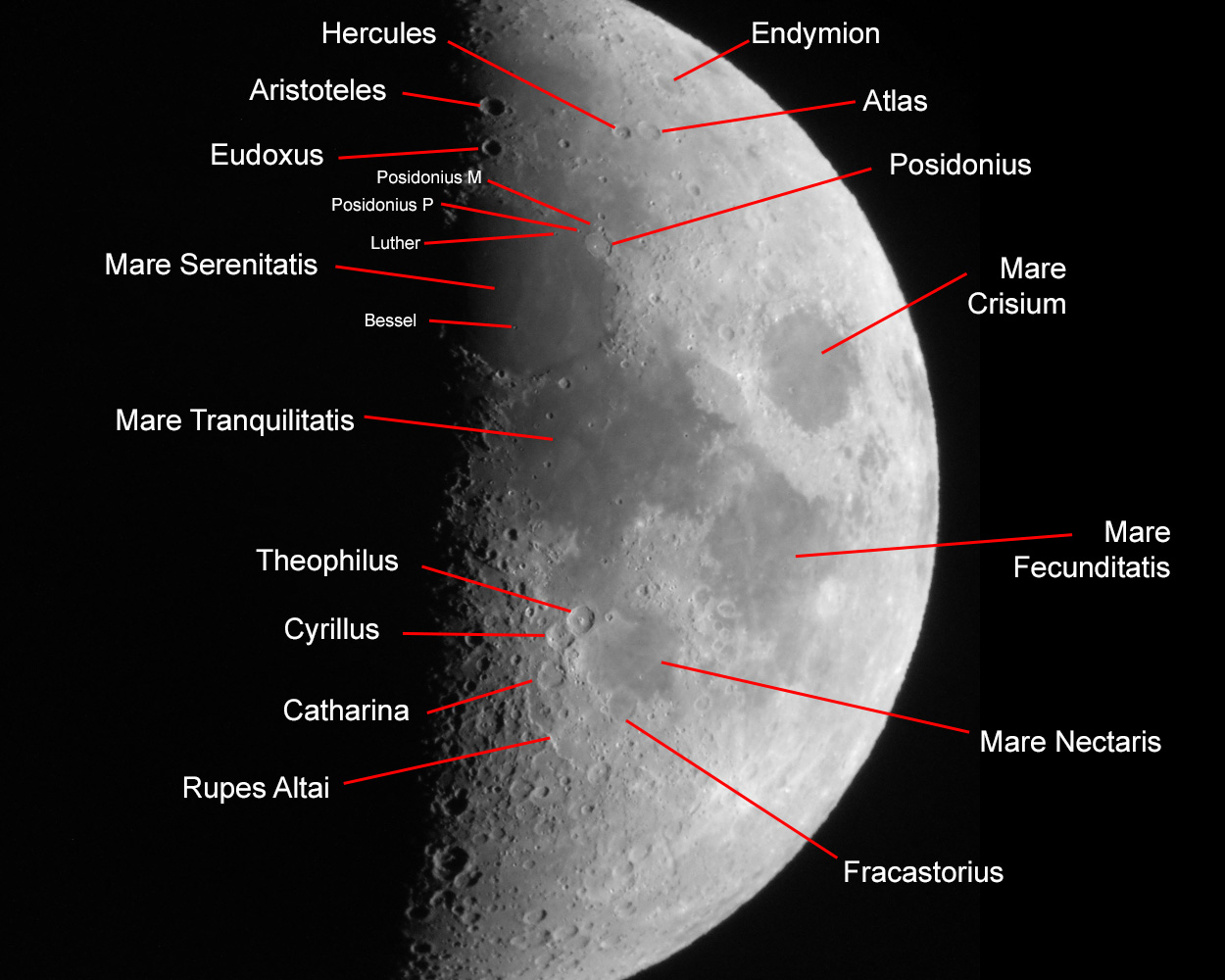 |
|
7 mm eyepiece |
Photo data: May 2, 2017, Sky-Watcher Skymax-102 telescope, Ricoh GR held to the 16 mm and 7 mm UWA eyepieces
Set 2
The next moon photo was taken with the 6" Newton telescope Sky-Watcher Explorer 150PDS and again with the camera held to the eyepiece (April 3, 2017; Half Moon shortly before 4 a.m.). I also show an enlarged section of the photo that emphasizes the region at the Terminator.
Because of the section, I moved the region where I am looking for small craters to the Mare Tranquilitatis, especially, in the surroundings of the small crater Ritter (31 km diameter). In the section you can even see the craters Ritter D and Arago B, both 7 km in diameter. These craters are not visible on the overall picture, but only the craters Ritter B and C (14 km diameter) and Schmidt (12 km diameter). This demonstrates how more pixels in the same image result in a higher resolution (7 km compared to 12 km).
 |
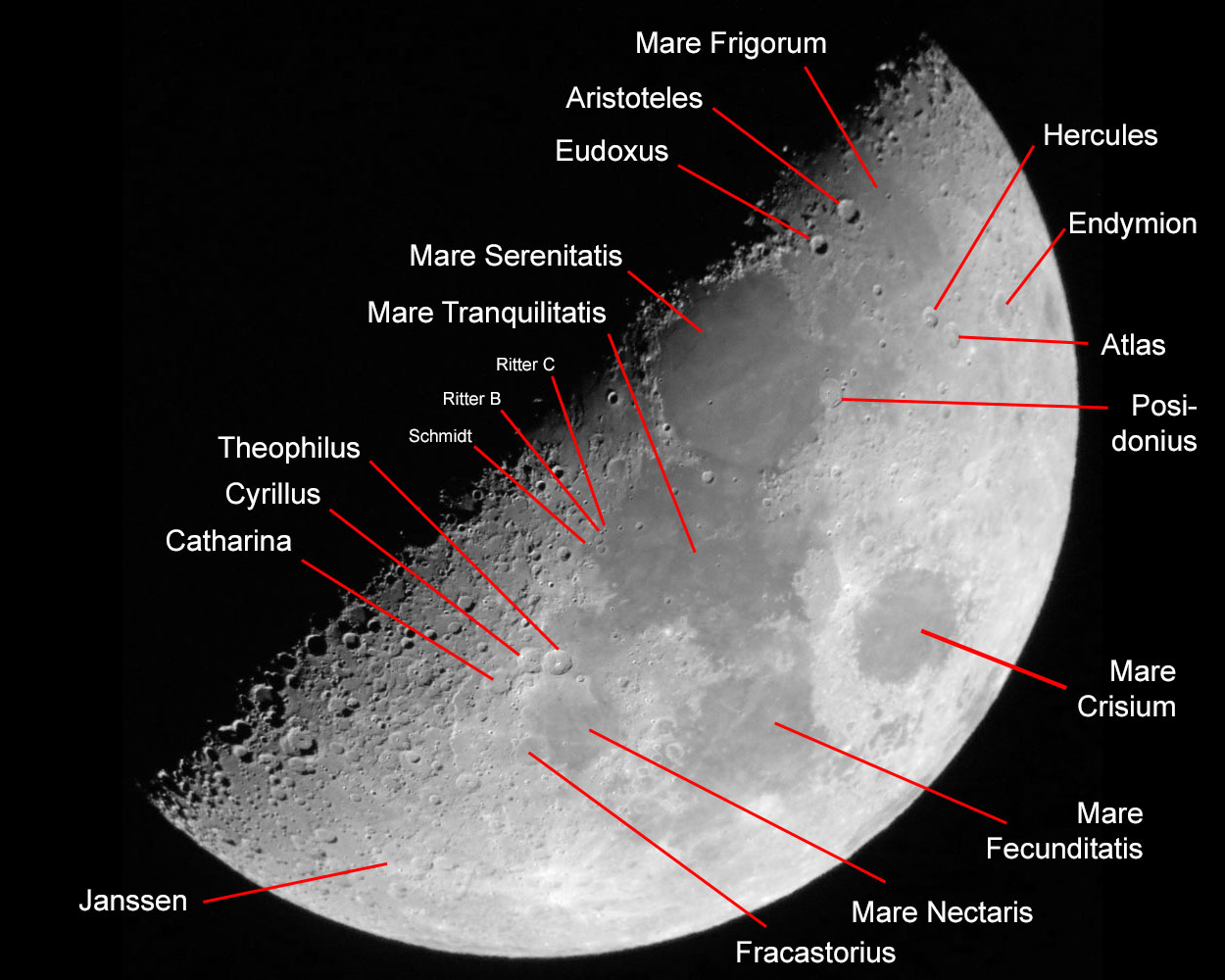 |
|
|
|
|
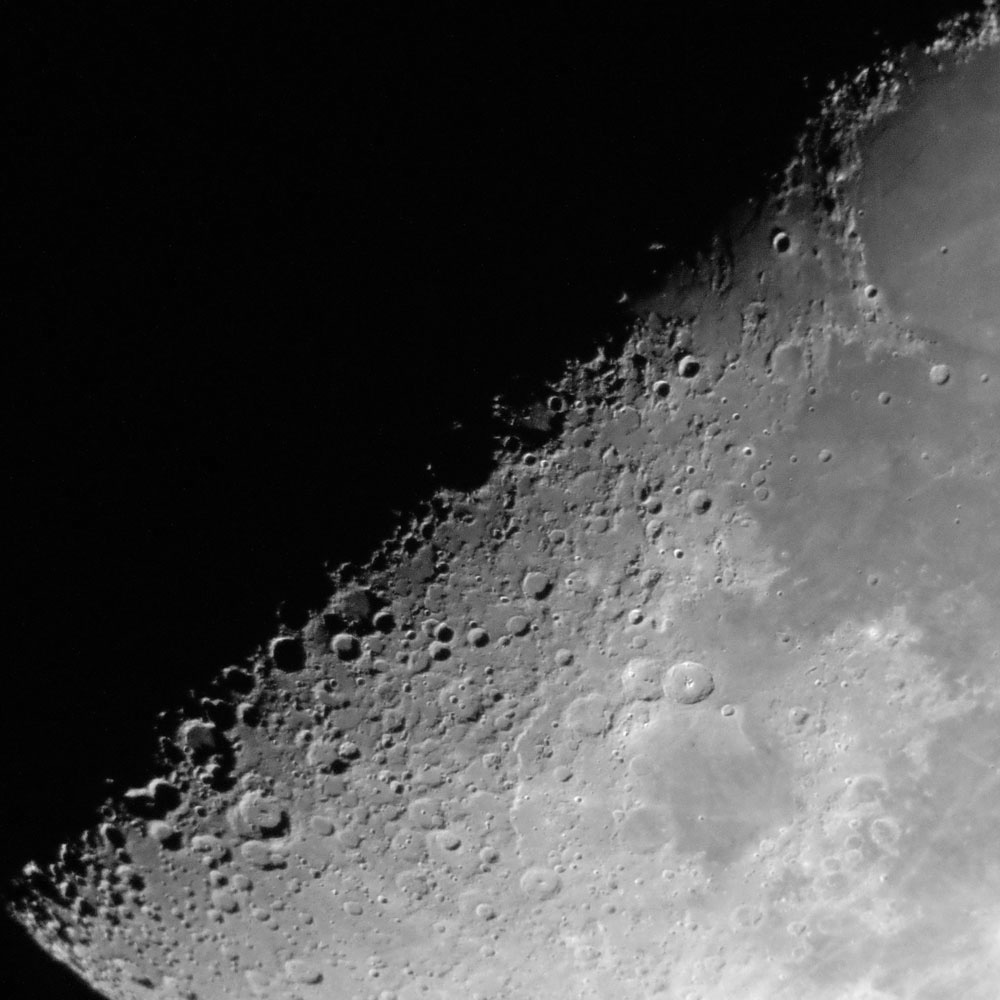 |
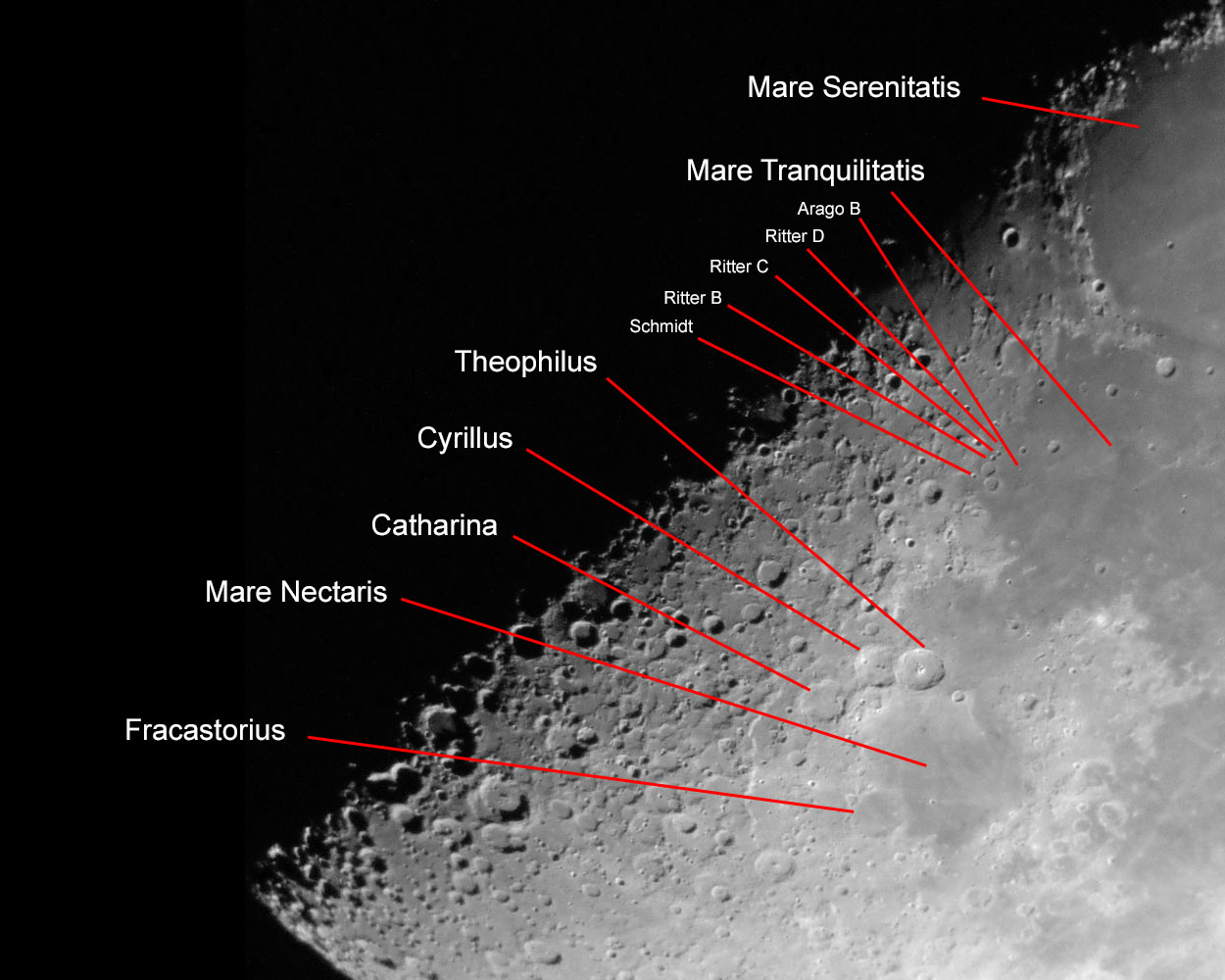 |
|
Section from the photo above |
Photo data: April 3, 2017, Sky-Watcher Explorer 150PDS telescope, Ricoh GR held to the 7 mm UWA eyepiece
Set 3
The following moon photo was taken on April 4, 2017, shortly after the day had begun - on April 3rd, shortly before 4 a.m., was Half Moon. The photos was taken with the Sky-Watcher Skymax-102 OTA and again with the camera held to the eyepiece.
You can easily see the crater Posidonius P (15 km diameter), but you can still see the craters Luther (10 km diameter) and Posidonius M (10 km diameter).
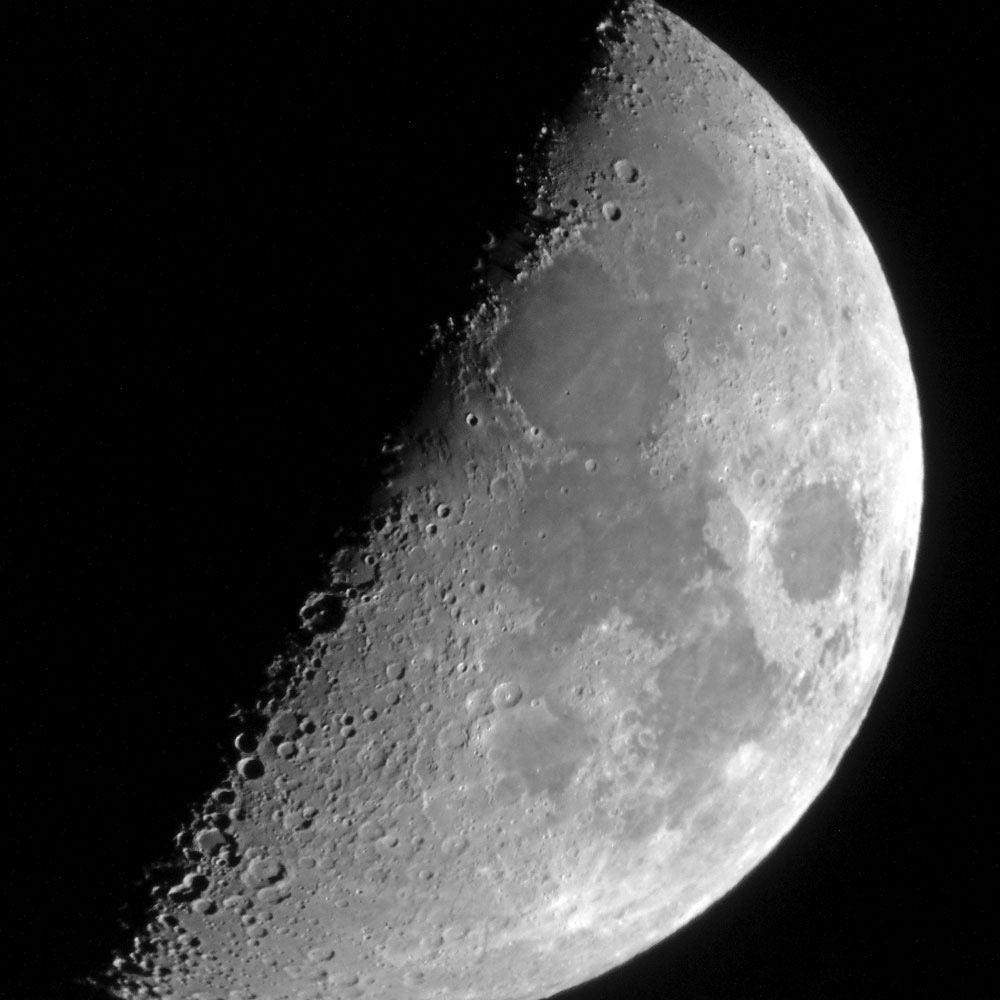 |
 |
Photo data: April 4, 2017 just after midnight, Sky-Watcher Skymax-102 telescope, Ricoh GR held to the 16 mm UWA eyepiece
Set 4
Finally in this series, this moon photo was taken on April 4, 2017 in the evening - on April 3rd, shortly before 4 a.m., was Half Moon. See the difference to the preceding photo! The photo was taken with the Sky-Watcher Skymax-102 OTA and again with the camera held to the eyepiece.
This photo is somewhat underexposed and therefore, has a lower resolution. I indicate the craters Hipparchus C (17 km diameter) and Hipparchus G (15 km diameter) as examples; Hipparchus L (13 km) cannot be recognized.
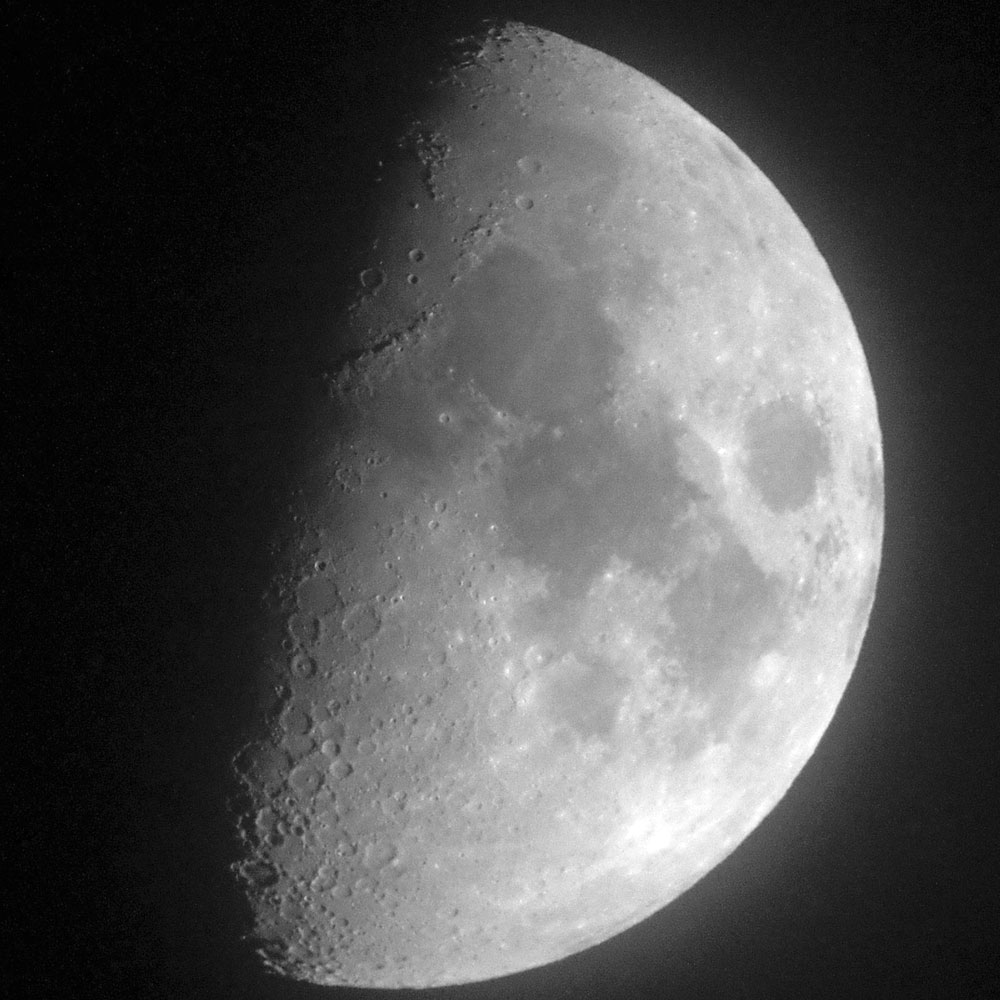 |
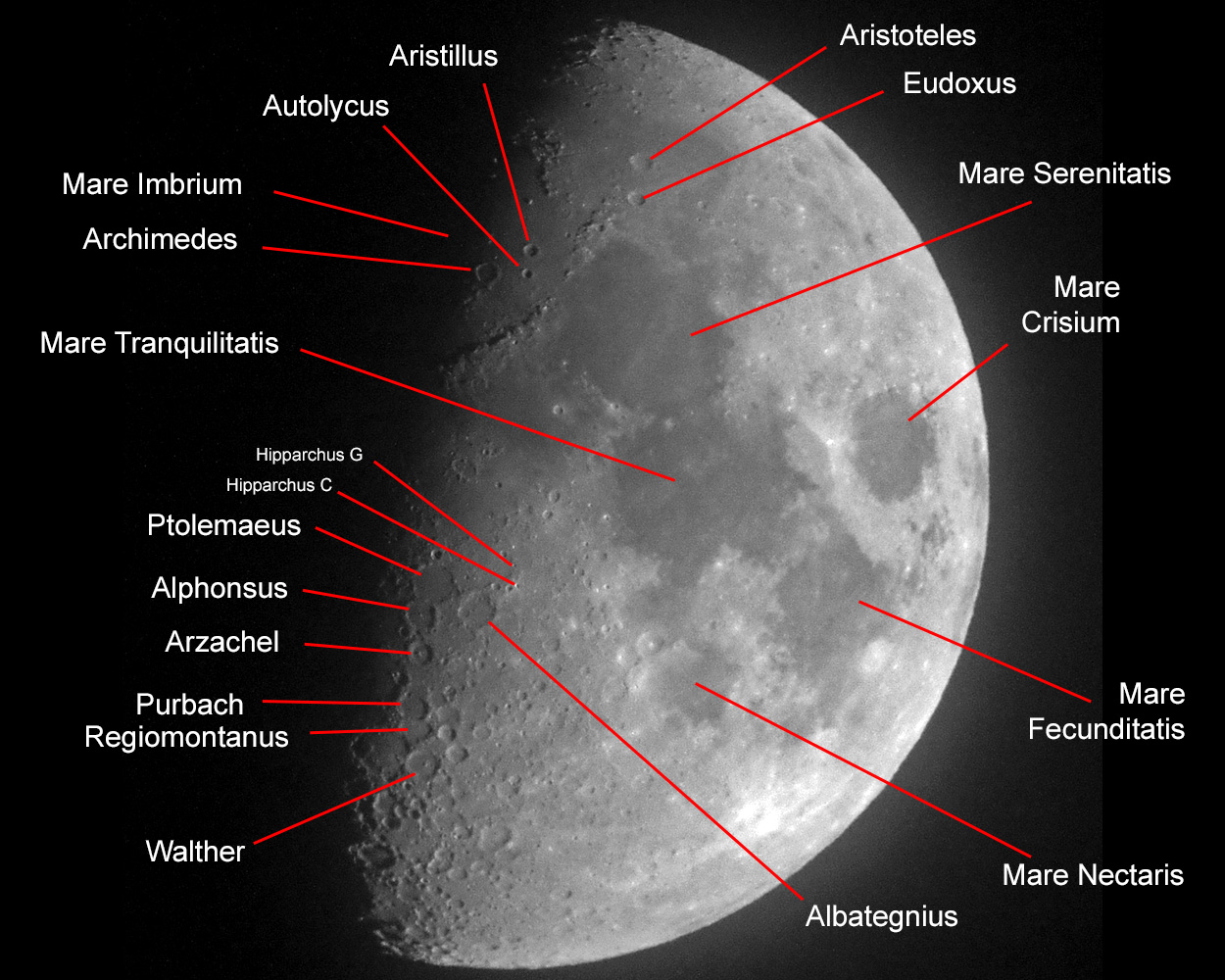 |
Photo data: April 4, 2017 in the evening, Sky-Watcher Skymax-102 telescope, Ricoh GR held to the 16 mm UWA eyepiece
Set 5
Now, an older photo in two different versions taken with the 5" Dobson telescope Sky-Watcher Heritage P130 and the camera held to the eyepiece (April 14, 2016; Half Moon at 5 a.m.). It seems to be timed beween the photos of set 3 and set 5. Moreover, the resolution of the photos is fairly low.
The crater Bessel (15-17 km diameter) can be seen well (particularly in the larger version), Posidonius P (15 km diameter) not quite as good. Both ca be seen better in the lower version.
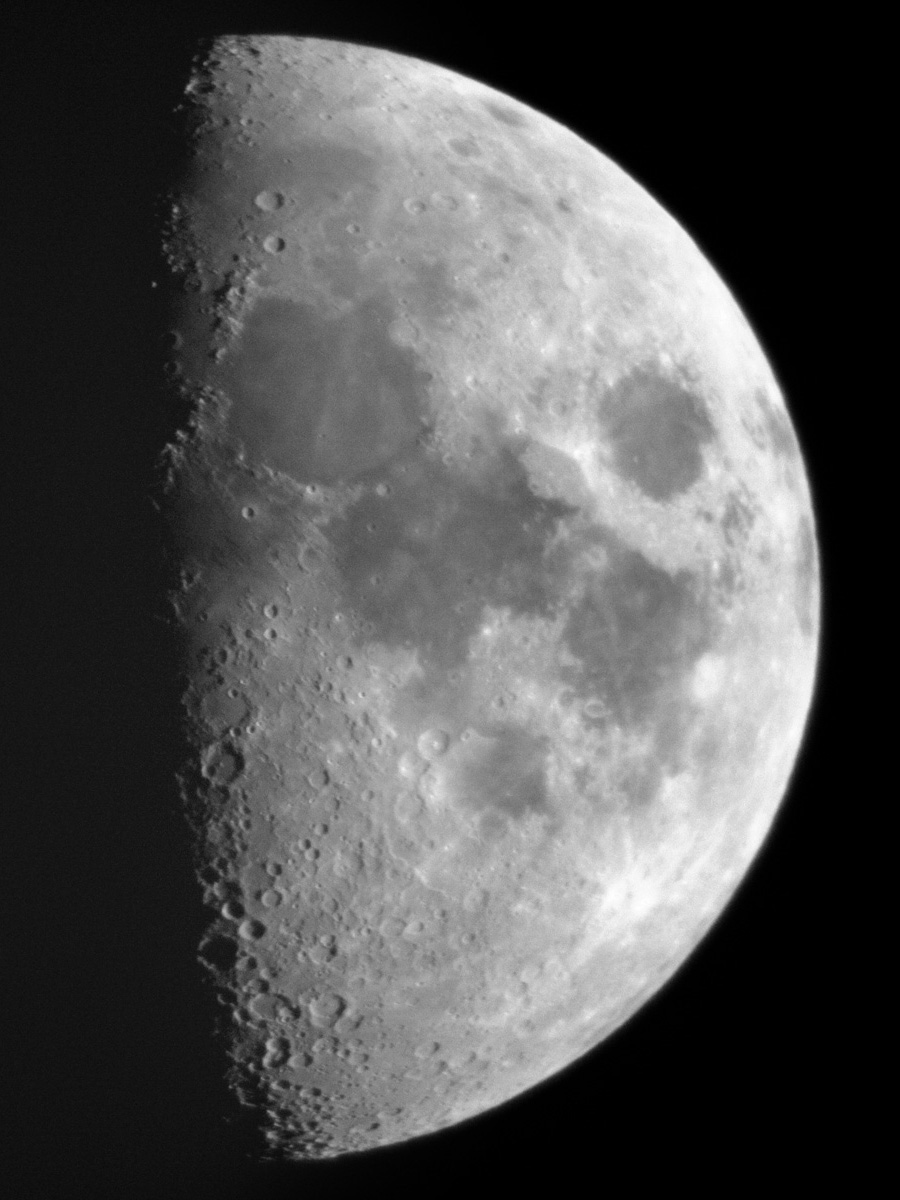 |
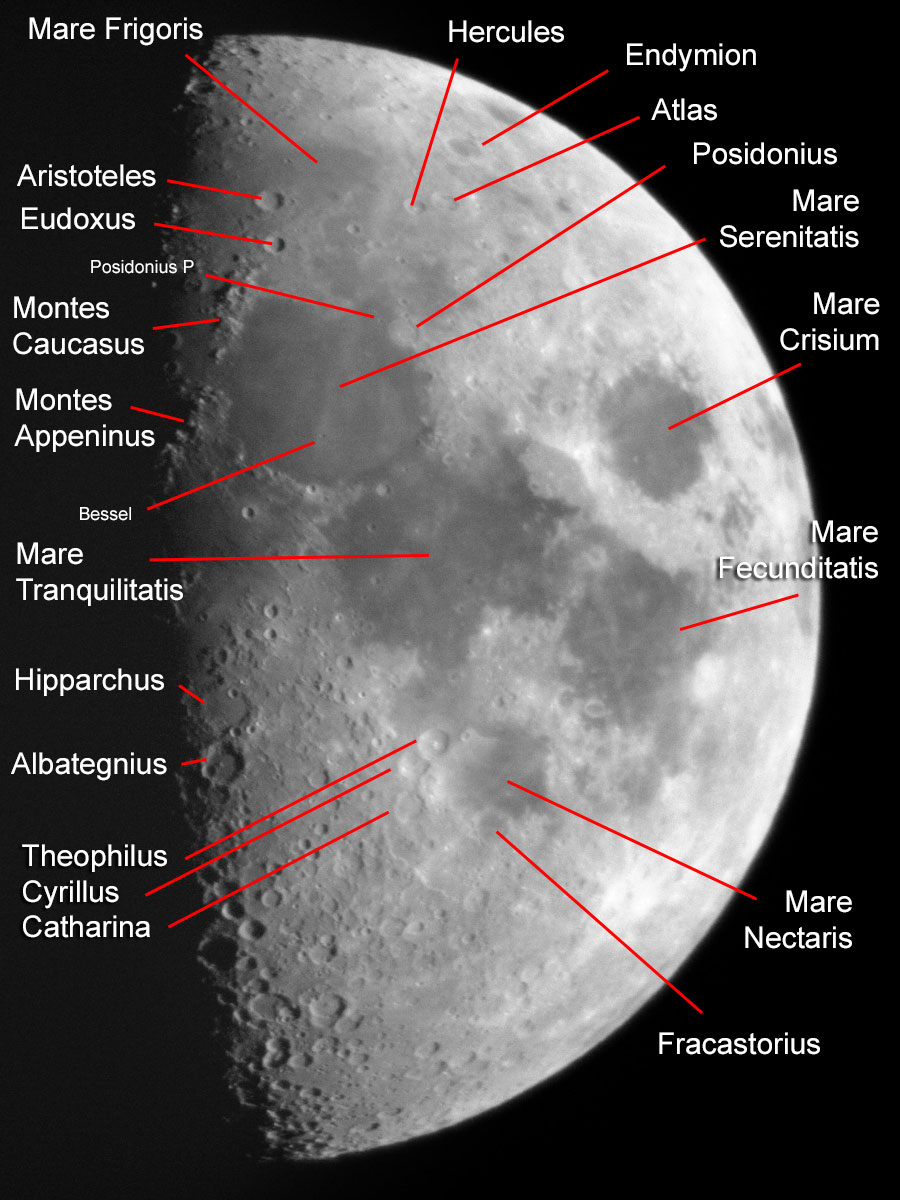 |
|
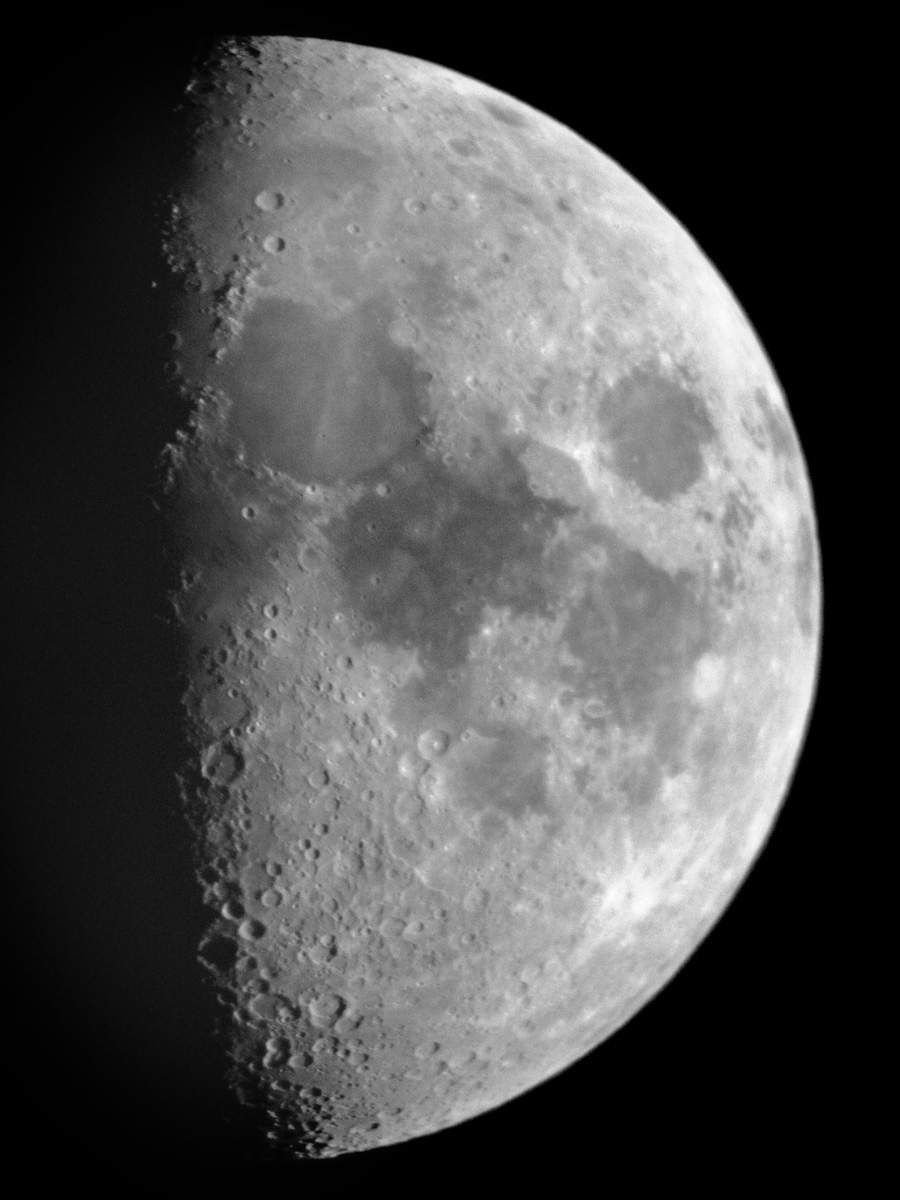 |
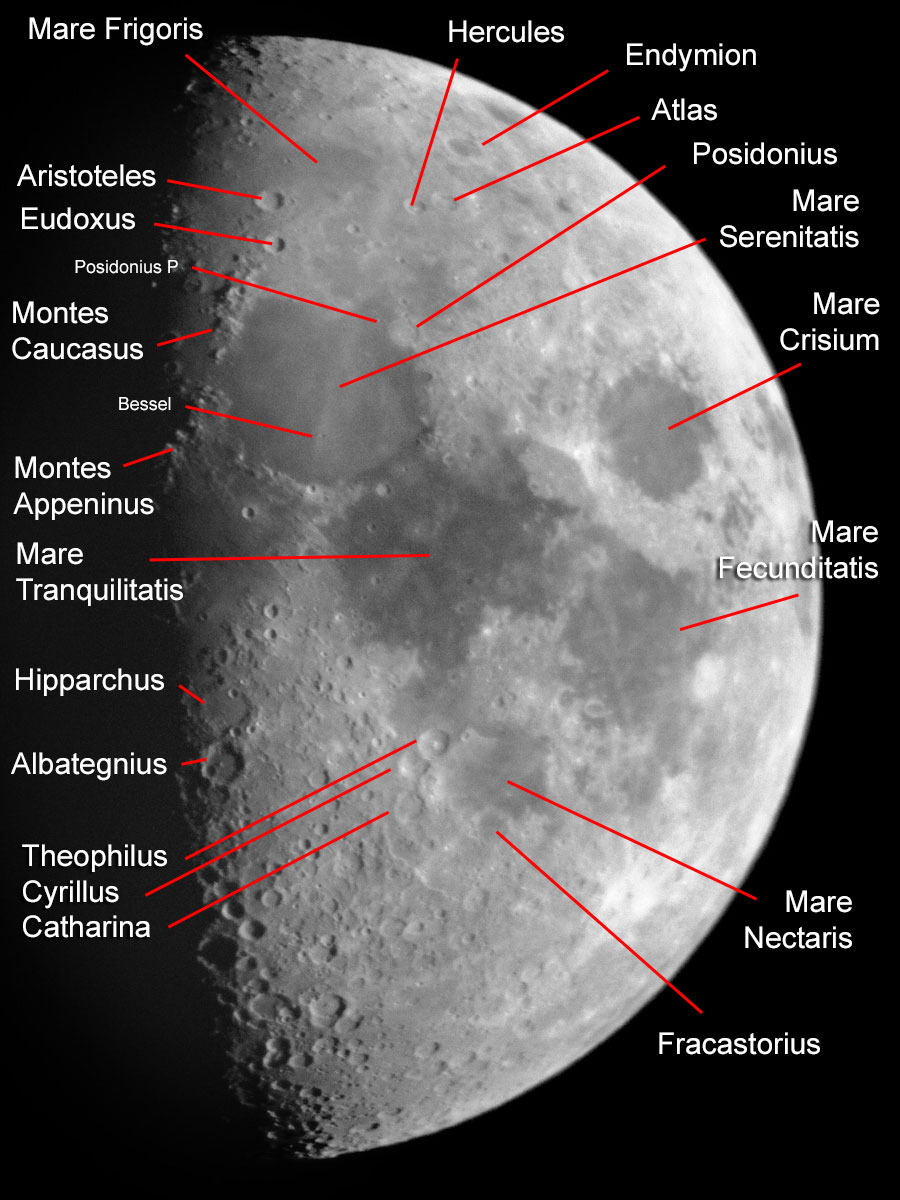 |
Photo data: April 14, 2016, Sky-Watcher Heritage P130 telescope, Leica M (Typ 240) with 50 mm lens, held to 16 mm UWA eyepiece
Set 6
These newer photos of the moon were taken on February 23, 2018 in the evening - this day was Half Moon shortly after 9 a.m.. The photos were taken with the Sky-Watcher Skymax-102 OTA and again with the camera held to the eyepiece.
These photos seem to demonstrate what is possible with the Skymax-102. I again indicate the craters Hipparchus C (17 km diameter) and Hipparchus G (15 km diameter) as examples; Hipparchus L (13 km) can be recognized as well because of the higher resolution. I also examined the original photos on the basis of a section and found out that craters in the range of 5-7 km are just to be guessed, but starting from 8 km craters can be recognized.
The first photo looks sharper and shows, for example, the shape of the Müller crater more correctly, but the second still seems to reproduce smaller craters better, obviously thanks to the more pronounced shades.
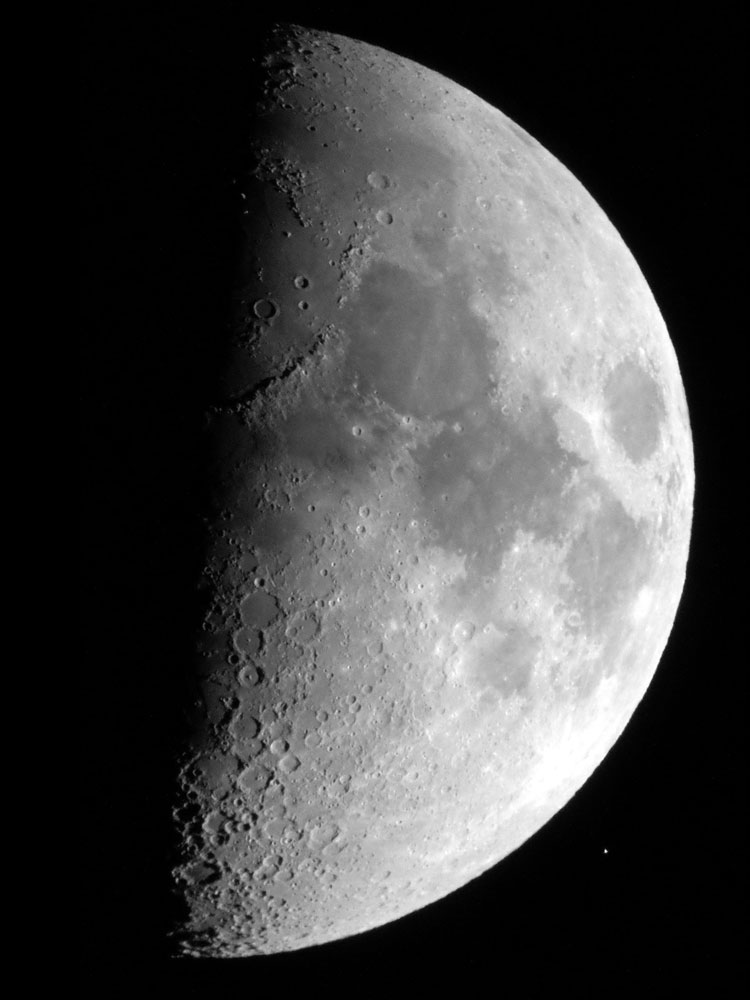 |
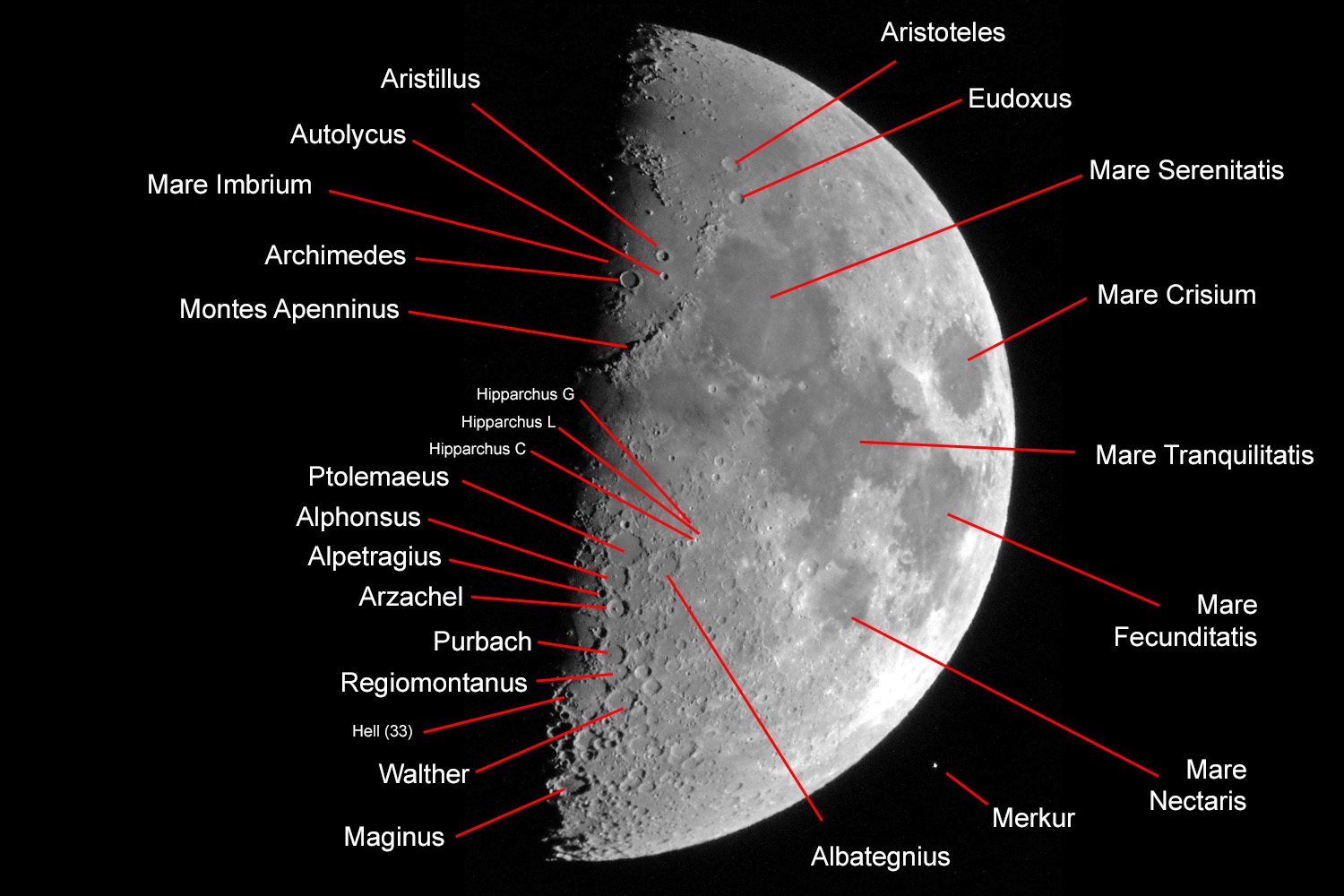 |
|
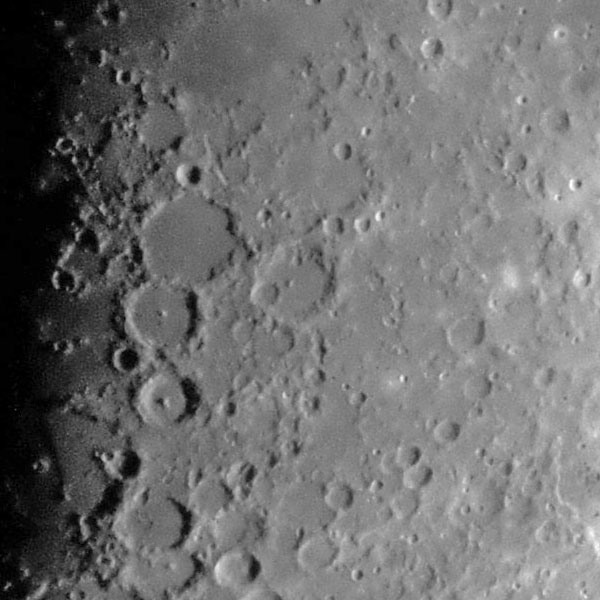 |
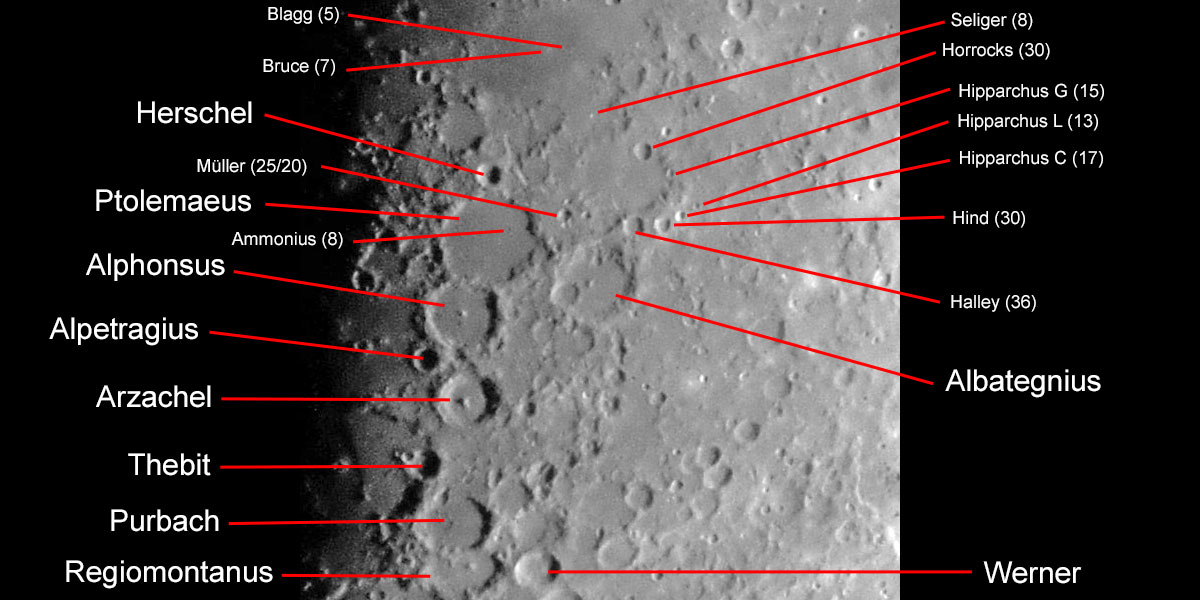 |
|
100% section |
Examples of small craters with diameters in km |
|
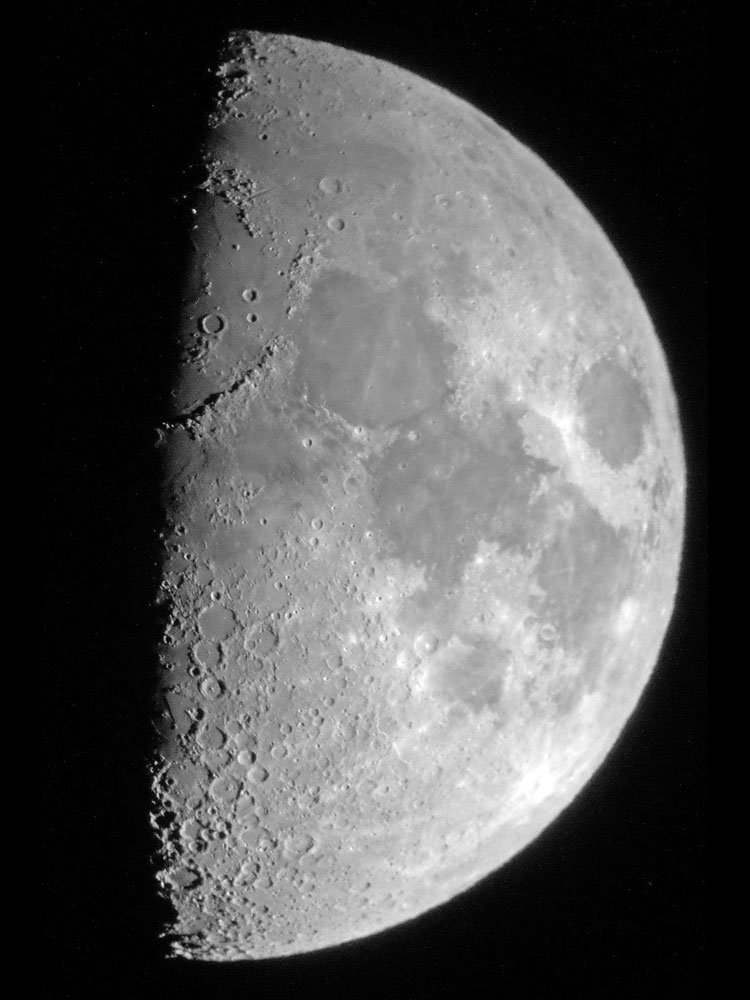 |
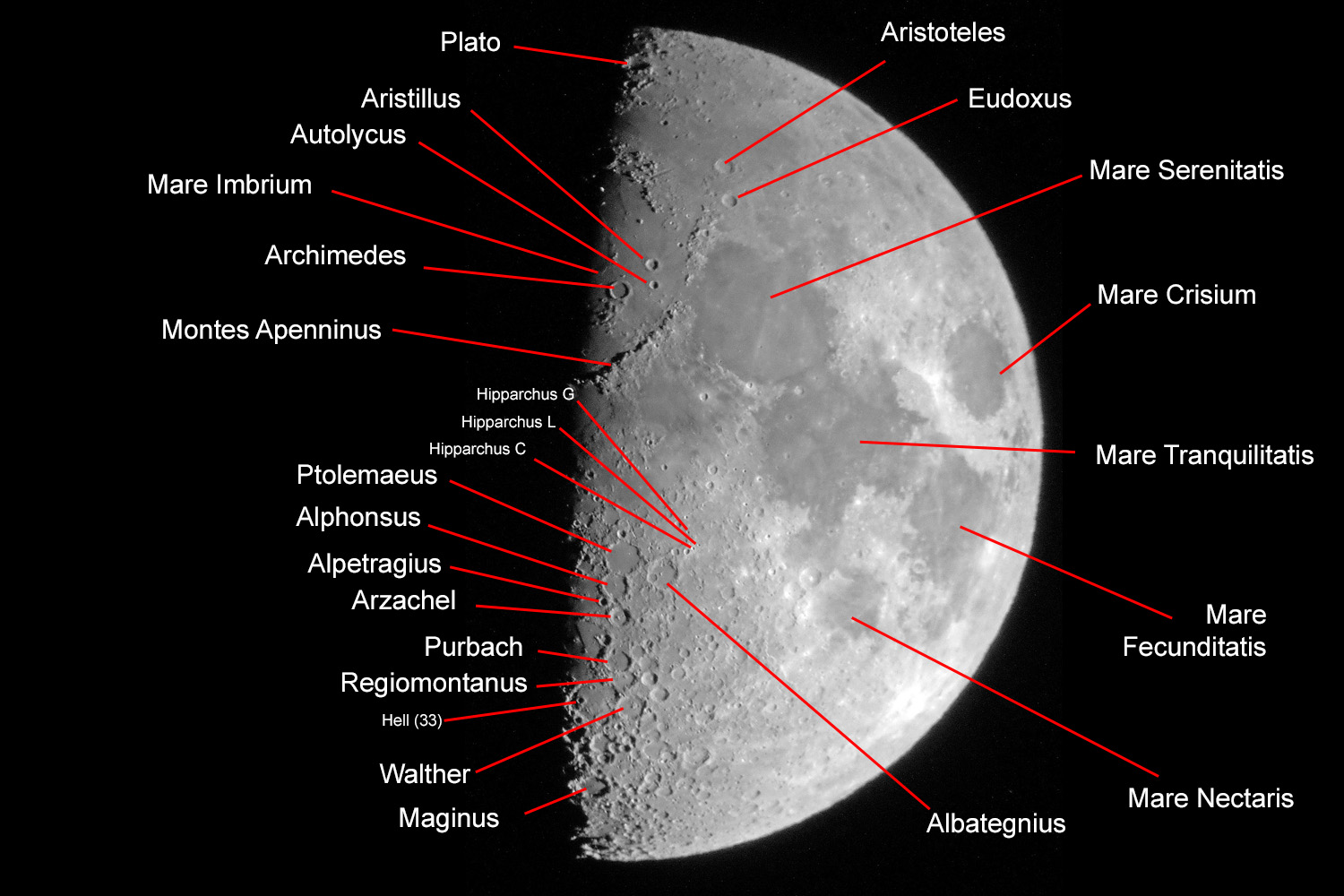 |
|
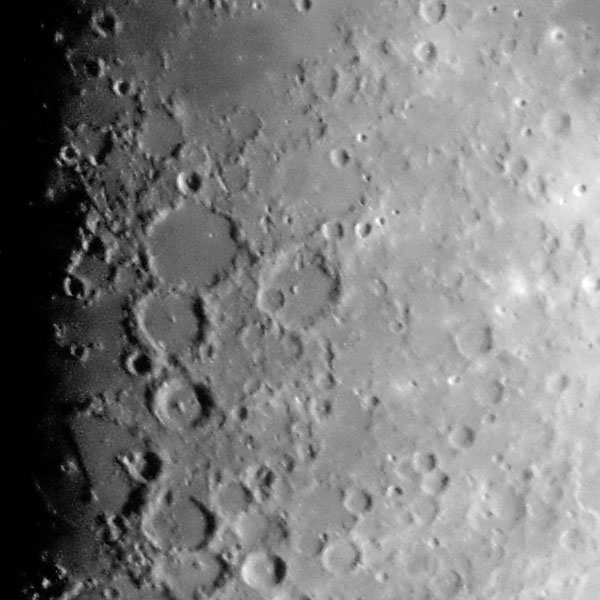 |
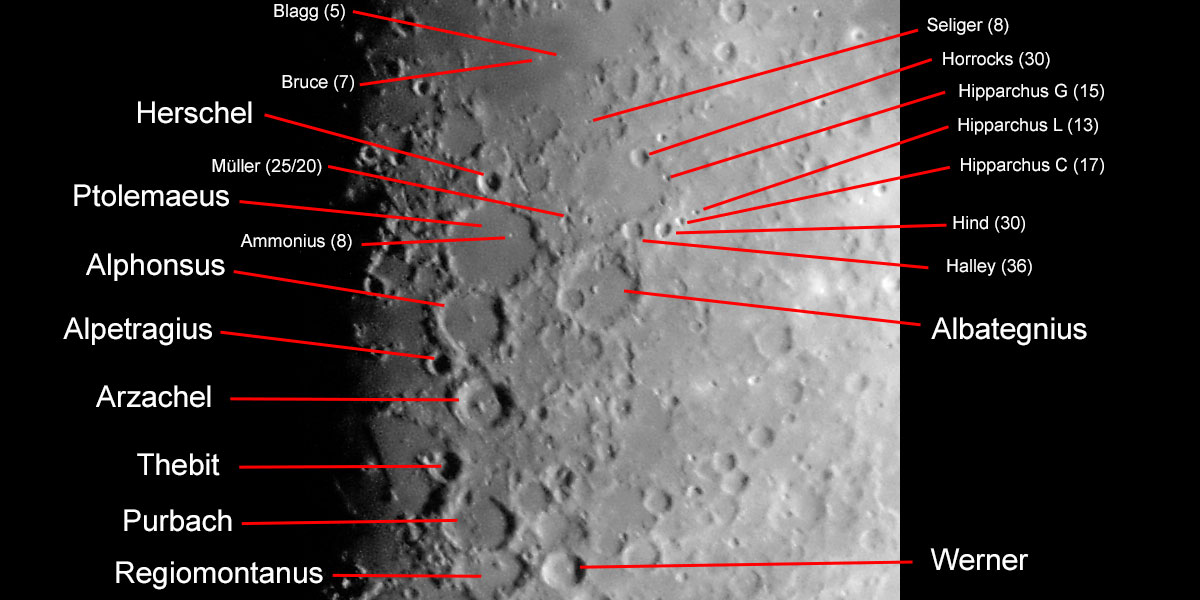 |
|
100% section |
Examples of small craters with diameters in km |
Photo data: February 23, 2018 in the evening, Sky-Watcher Skymax-102 telescope, Ricoh GR held to the eyepiece
Set 7
This newer photo of the moon was taken on February 23, 2018 later in the evening - this day was Half Moon shortly after 9 a.m.. The photo was taken with the Sky-Watcher Skymax-127 OTA and again with the camera held to the eyepiece.
This photo has a slighly higher magnification than the previous ones because of the longer focal length of the Skymax-127. All in all, it seems to demonstrate what is possible with the Skymax-127. I once again indicate the craters Hipparchus C (17 km diameter) and Hipparchus G (15 km diameter) as examples; Hipparchus L (13 km) can be recognized as well because of the higher resolution. I also examined the original photo on the basis of a section and found out that craters in the range of 5-7 km are just to be guessed, but starting from 8 km craters can be recognized.
While I cannot see that small craters are reproduced better than in the previous photos, at least, the crater Müller appears in a more correct form than on the second photo there. All in all, the photo taken with the Skymax-127 looks sharper and more detailed than the ones taken with the Skymax-102, but this can also be due to the different shooting conditions.
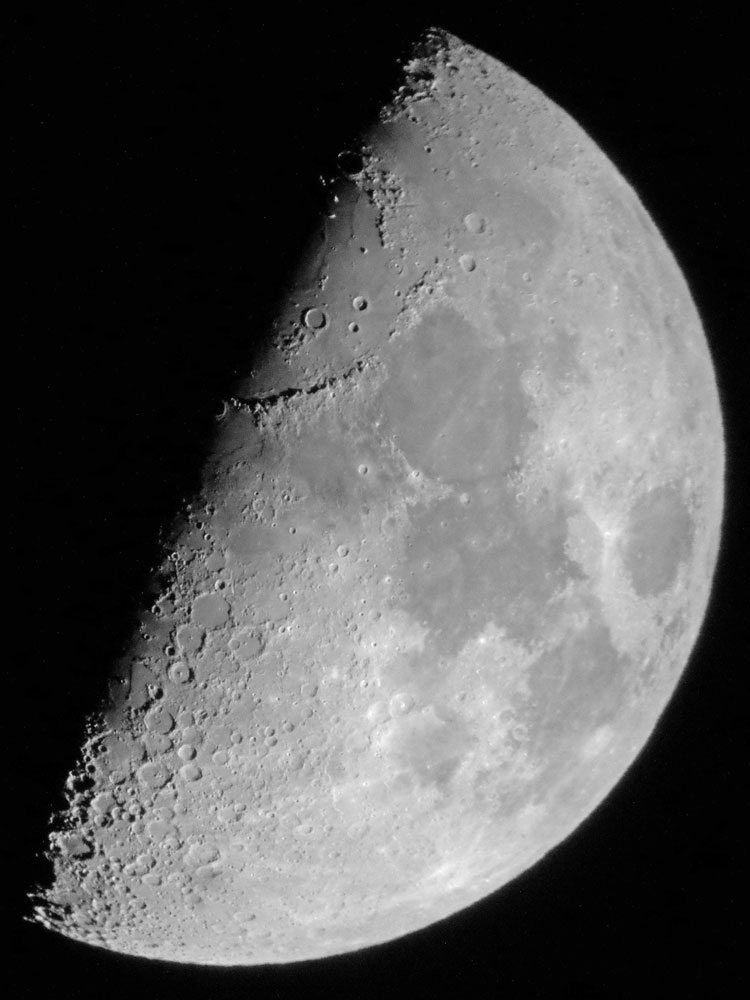 |
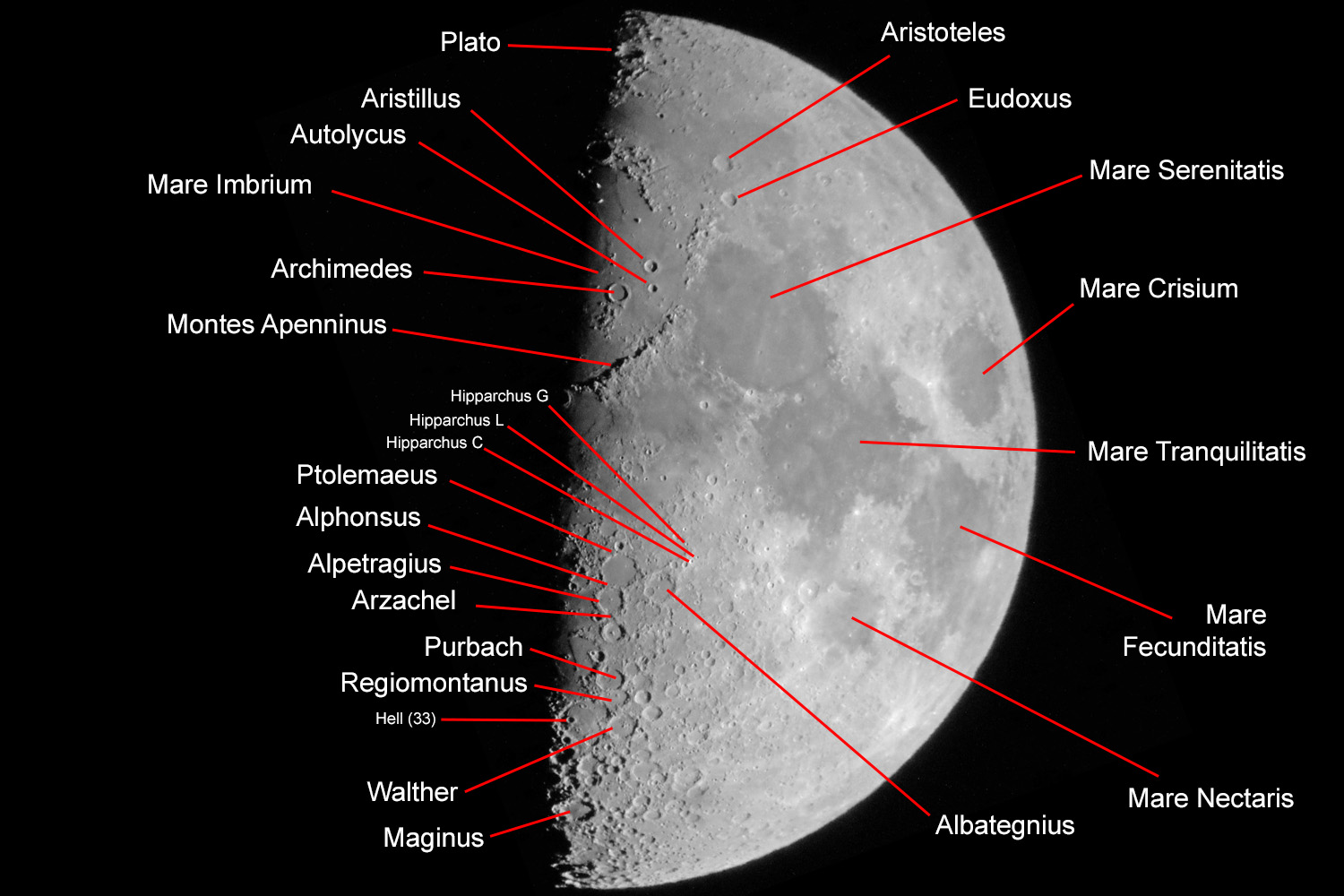 |
|
Moon rotated -20 degrees because of the labels |
||
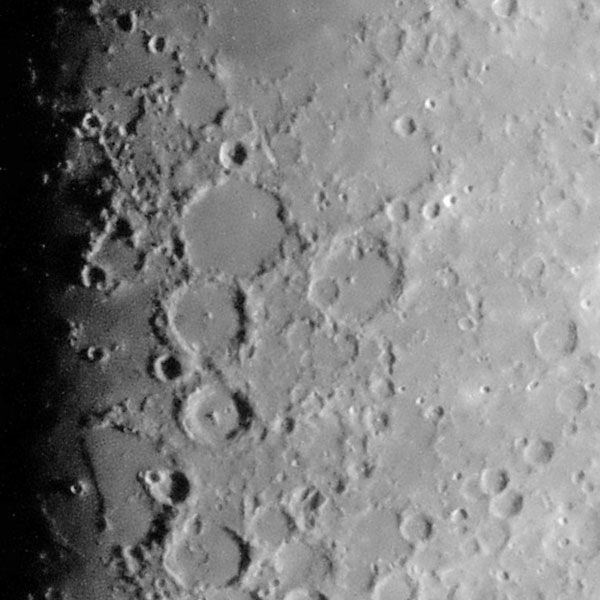 |
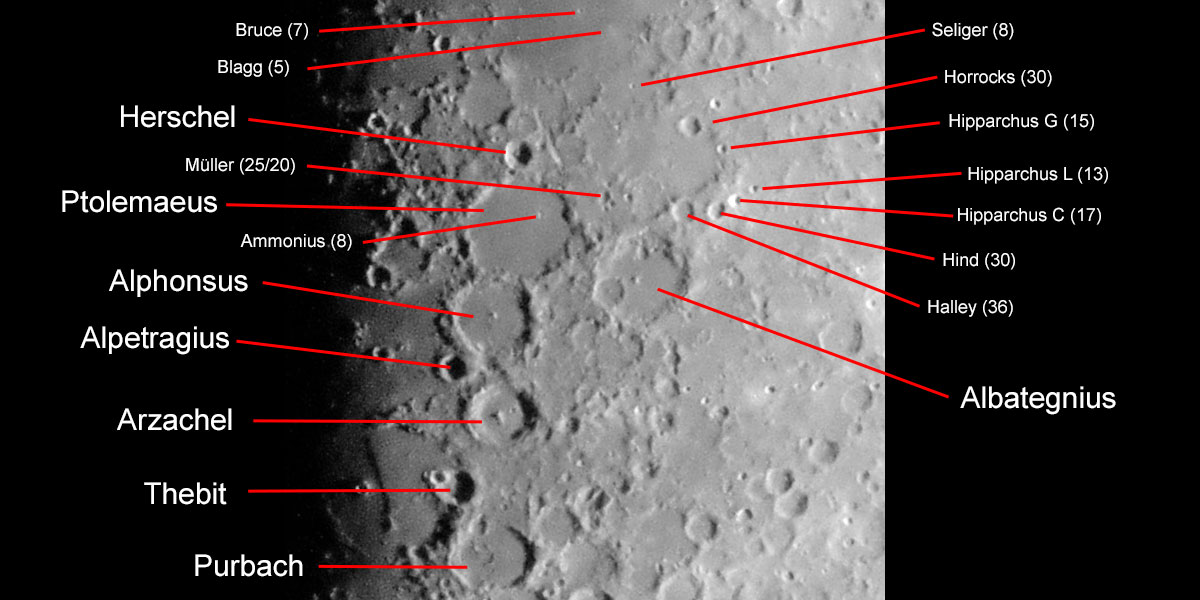 |
|
100% section |
Examples of small craters with diameters in km |
Photo data: February 23, 2018 late in the evening, Sky-Watcher Skymax-127 telescope, Ricoh GR held to the eyepiece
References
- Mond (Wikipedia): de.wikipedia.org/wiki/Mond
- Moon (Wikipedia): en.wikipedia.org/wiki/Moon
- Lambert Spix (2013, 3. Auflage). moonscout - Mondmeere, Krater und Gebirge einfach finden und beobachten. Oculum-Verlag. ISBN 978-3-938469-58-3
- Lambert Spix & Frank Gasparini (2011, 1. Auflage). Der Moonhopper. Oculum-Verlag. ISBN 978-3-938469-54-5
- Ronald Stoyan, Hans-Georg Purucker (2013, 1. Auflage). Reiseatlas Mond. Oculum-Verlag. ISBN 978-3-938469-64-4
- Virtual Moon Atlas: ap-i.net/avl/en/start
| 09.03.2019 |